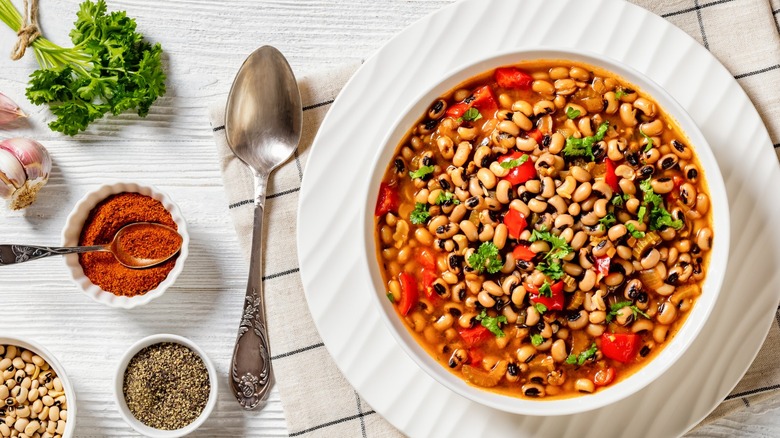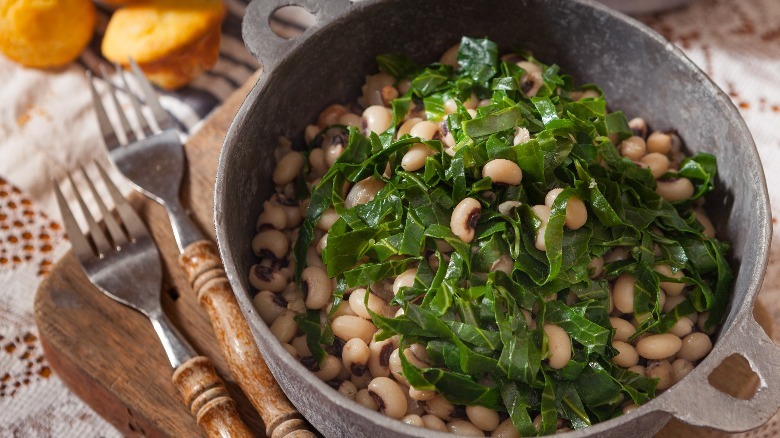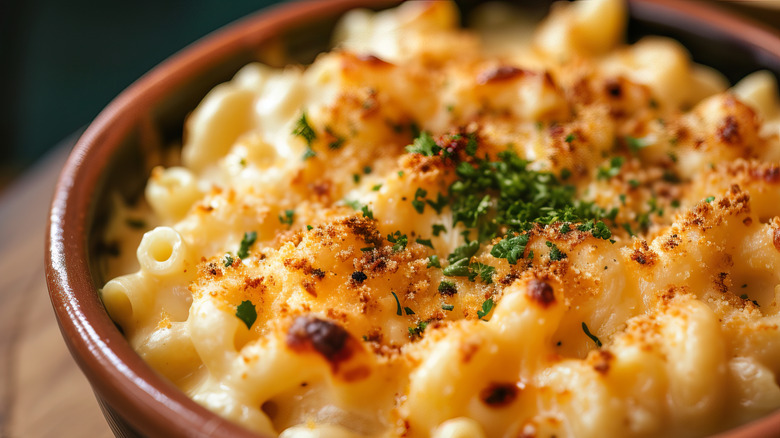Why You'll Often See Red, Black And Green Colored Foods On The Table For Kwanzaa
At the Karamu Ya Imani (Feast of Faith), held on December 31, the foods that adorn the tables from end to end embody the vibrant hues of Kwanzaa: black, red, and green. The holiday's color palette draws its inspiration from the symbolism of the Bendera, the Pan-African flag, which represents unity among African diaspora. Red denotes the struggle and the liberation of the people, black represents the people themselves, and green is emblematic of hope for the future. And foods such as red beans and rice, black-eyed peas, and collard greens count among the recipes that are not only traditionally served on Kwanzaa but which also embrace the colors of the holiday.
There are no rules about what you should or shouldn't serve at Kwanzaa, but the menu choices featured during the karamu are influenced by a number of cultures, with foods from Africa, South America, the Caribbean, and the American South featuring heavily on Kwanzaa menus. And as with other holidays throughout the year, it's common to bring dishes that reflect the holiday's color scheme to the table.
Red Kwanzaa foods
Foods in the red or red-orange category include comfort food classics like Nigerian jollof rice and leg of lamb served with blood oranges as garnishes. Even mashed sweet potatoes and sweet potato pie, while orange, bring a similarly welcome pop of warmth to the table. You'll probably also find a one-pot meal like red red bean stew, Ghanaian chicken and peanut stew, or Cajun jambalaya sitting at the center of a Kwanzaa spread. Any and all of these delights may be served with a sorrel spritz mocktail, a popular Jamaican drink flavored with cloves, cinnamon, and ginger, to wash things down with.
Green Kwanzaa foods
Kwanzaa's colorful culinary tour continues with green foods like mustard or collard greens, fried okra, and Jamaican jerk chicken served with wedges of lime (which is technically both black and green).
Each of these dishes provides a bit of archeology on a plate, the okra a solemn reminder of the ancestors' journey to the States, the greens of the ingenuity of enslaved people, and the jerk chicken of unity among all African diaspora. In short, no matter what you serve, the food allows celebrants to embrace the origins of Kwanzaa foods all the way back to their roots.
Black Kwanzaa foods
There aren't many truly black-hued foods, but foods with some black on them, like black-eyed peas, and purple and brown stand-ins come close. Some of them, like Asia-native eggplant, now grow readily out of the savannas of Africa and, like okra, were among the foods enslaved peoples brought with them from Africa to America and other destinations. In modern times, these foods count among the offerings that adorn Kwanzaa tables. Along with okra, it often gets assigned a supporting role as a side dish or part of dinner as an ingredient in soups or stews. The rich, dark interior of savory Jamaican beef patties provide a look at some of the dinner recipes that are popular during the holiday.
But it isn't only savory foods that make up Kwanzaa celebrations. Dessert foods and drinks like malva pudding and bourbon hot cocoa end a Karamu Ya Imani on a sweet note. Because Kwanzaa is meant to celebrate Black culture since before the days of slavery and on through to the present day, the dishes served during meals reflects the long history of Black peoples.
Other foods that are served during Kwanzaa
Finally, while red, green, and black foods can be associated with the holiday, there also aren't many hard-and-fast rules that dictate the foods' color palette or the kinds of foods served. Expert-approved holiday cookie trays include red and green cookies for Christmas and blue and white cookies for Hanukkah, but they still include plenty of other colors on the cookie tray. Similarly, you can find plenty of foods that aren't red, green, and black during Kwanzaa celebrations.
It's best to remember that the choice to feature color-themed foods is just one more way to add to the festivities (and may often be more happy coincidence than deliberate design). Since the holiday's feasts are inspired by African harvest rituals and festivals, both traditional dishes and modern ones like corn bread, fritters, macaroni and cheese, coconut pound cake, fried catfish, and other dishes indicative of soul food from the American South and beyond are welcome at Kwanzaa tables too.


